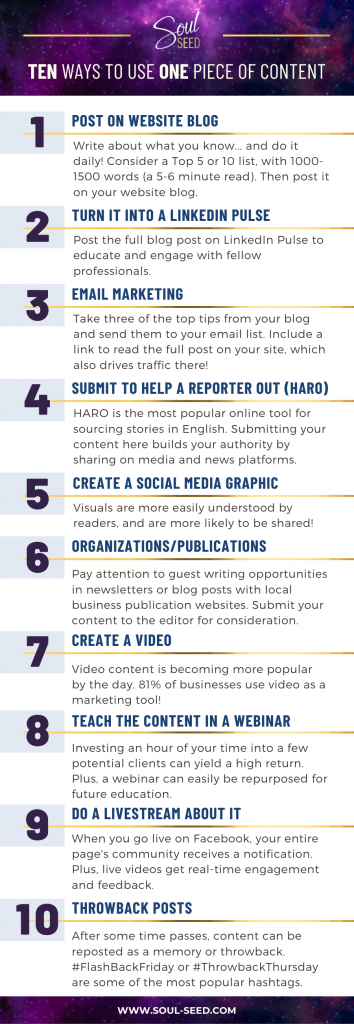Today, we’re sharing practices to consider for developing your digital marketing strategy.
Now, before diving into anything, remember that what applies to you and your business is going to depend on your growth goals and stage of business. Not every business needs or desires the same approach as another. We have clients who engage social media, and some who don’t. We have many clients who come to us thinking they need a robust digital marketing funnel when what they actually benefited most from was receiving coaching to help improve their sales conversations and increase conversions. Sometimes you don’t need more leads and what you actually need is to improve your close rate with the lead opportunities that you do already have. Our intention is to help you think holistically about your strategy. If you want to get more strategic with your growth in 2022 there is still time to join us for virtual Soulful Strategic Planning for Solopreneurs, Small Businesses and Startups.
We understand that marketing can feel overwhelming. Heck, it’s common for business in general to get overwhelming. To help manage that overwhelm it’s important to evaluate where your specific business is in the growth journey and what the most critical growth steps are for the year ahead so you are addressing the most strategic areas for growth. Where are your gaps in your business? And is digital marketing a part of the solution? If you desire business growth and aren’t sure where to start, hopping on a consult with us is always an option!
Below is a list of topics we cover in the blog, which are hyperlinked to each section. Looking for quick answers to your digital marketing questions? Click the links below to navigate to each section.
-
What is a digital marketing strategy?
-
What is lead generation in digital marketing?
-
How to create a digital marketing strategy
-
How digital marketing affects consumer behavior
What is a digital marketing strategy?
By definition, a digital marketing strategy is your organization’s plan for achieving goals that align to your overall brand strategy through selected marketing channels such as paid, earned, and owned media. Paid digital advertising includes things like Facebook or Google ads, earned media and PR coverage, which includes nurturing relationships and securing PR exposure through podcasts, TV and radio interviews, and print publication stories. Owned media are things your brand owns such as optimizing your website through search engine optimization and SEO enhanced blog articles that help to educate your customers and drive traffic to your website.
The term “digital marketing” can refer to a lot of things… including, but not limited to, social media, text marketing, video marketing like YouTube, TikTok, or Instagram reels, email lead-generation marketing, and more.
With so many areas covered by this blanket term, it’s no surprise that the concept of digital marketing strategy can quickly become overwhelming for many businesses!
Take comfort in knowing that although there are many facets of a solid digital marketing strategy, what’s most important is defining the best fit for your audience and ensuring that you have the capacity and resources to manage whatever methods you commit to so that you can implement it effectively and consistently.
What is lead generation in digital marketing?
Lead generation is the process of attracting people to your products and services, and then converting them from the awareness stage to eventually becoming prospects over time (with the ultimate goal of becoming a paying customer, of course!).
There are many strategies used in digital marketing to generate leads, but what they all have in common is they start with an attractive offer that makes the potential lead willing to exchange something of value (typically money or information) to receive what you’re offering.
Some examples of lead generation strategies might include:
- An online quiz that requires users to enter their name and email to receive their results.
- Requiring users to enter their information to book a free consultation on your calendar.
- Filling out an application to enter a drawing for a free ticket to an event or workshop.
- Signing up to receive a free PDF informational guide in their inbox.
- Trying a limited-time free trial of a product or offer.
Lead generation is an important aspect to consider when you’re planning your overall digital marketing strategy and includes all the action steps that are taken as the potential prospect gets to know, like, and trust you enough to become a paying customer. Just like how people rarely get married on the first date, it’s the same with marketing to your customer. A customer rarely purchases the first time they learn about your product or offer, and this is especially true for higher ticket items such as home repairs or remodels, or professional services like legal, consulting, or coaching.
How to create a digital marketing strategy
Your digital marketing strategy process is made up of eight simple steps that will help you clearly define your goals, determine the best methods to reach them, and regularly assess progress toward those goals.
Start with your brand strategy.
Your brand strategy is your strategy for scaling your brand and it starts with defining why your business exists and whom it’s aiming to serve and help. The brand strategy is the foundation of any marketing effort as it informs your strategic priorities.
Define your strategic objectives.
Use the acronym SMART to make sure the goals you’ve chosen for your strategy are Specific, Measurable, Achievable, Relevant, and Time-bound. For example, “Increase the conversions of our Facebook ad campaign by 25% in the first quarter of 2022” is a “SMART-er” objective than “Make more sales next year.” Then, remember to put systems and processes in place to track progress toward those objectives!
Understand the audience.
This may involve developing customer personas that go beyond just the usual demographics like age and household income. Consider not only the demographics of your ideal buyer(s) like their age, where they live, and household income, but also go deeper to understand how they think and feel. While it’s important to know your targeting so you can target ads toward ideal demographics, it’s by truly understanding the beliefs and decision-making patterns of your audience that will enable you to develop effective ad messaging and design (in the next step).
Develop the message.
Once you know who you’re aiming to reach, it’s important to communicate to them in a way that authentically speaks to their discomforts and desires. Consider what their discomforts or pain points are. What issues or challenges do your products and services aim to solve? What objections will they have that stop them from making a purchase they actually want to make? The clearer the picture you can paint of your ideal client’s core beliefs and values, the better your chances of being able to speak clearly to them with your digital marketing strategy. Too many companies make the mistake of focusing on product features, but, remember, your customer isn’t buying a product feature, they are buying a solution to their problem. (If you’re seeking help to develop brand messaging that establishes authentic connections and moves clients to action, reach out).
Choose the channels.
Determine where and how you will implement digital marketing. Will you engage social media platforms? Which ones? Will you drive leads to an opt-in? Run paid ads to drive consults? Choosing your channel often goes in combination with a planned-out content strategy (as noted below).
Identify what “tools” are in your toolkit.
One of the best ways to do this is by evaluating the performance of what’s currently in place. Understanding what you’ve already accomplished and what’s driving the most traffic to your business will help you assess what will be most effective in reaching the strategic objectives you’ve set. Sometimes you don’t need to implement more things, but, rather, invest more into what is already working.
Create a budget based on KPIs.
Once you know your business goals, such as “drive 10 new leads per month, because that equals 5 new customers per month,” now you can work with a professional digital marketing firm to help you understand the budget and strategy that will be required to achieve those results. Too often people start with a budget, rather than starting with the business goals they are aiming to achieve. At Soul Seed, we help businesses be more strategic with their marketing investment by looking at what it is you are aiming to accomplish and then advising on what it will require to achieve those results so you can make informed strategic investments.
Consider how digital marketing is a part of your overall content marketing strategy.
Depending on the channels you choose to align with your strategic objectives, you’ll want to create a content calendar that utilizes best practices for each medium, speaks to your ideal client, and positions your brand in the best way for that channel. It’s about working smarter, not harder. Check out the graphic below for ten ways to utilize one piece of content!
How digital marketing affects consumer behavior
Digital marketing and constantly-evolving technology have had a profound impact on consumer behavior during the internet age. This effect is compounded by the COVID-19 pandemic, which has many people worldwide spending more time at home and online, therefore relying even more heavily on social media for news, commerce, and interpersonal connection.
Digital marketing provides on-demand, real-time solutions for consumers – and the modern consumer has become conditioned to expect it. High levels of engagement and interaction via comment threads, email chains, and live chats create the opportunity for excellent customer service. However do not mistake a digital marketing platform for replacing authentic human connection!
Digital marketing is a tool to help facilitate relationship building and in some cases your digital content or ad can drive a consumer directly to a sale, especially for lower ticket items. A mistake that many companies make is thinking that a digital platform alone is enough to build the relationship directly to the sale. That may or may not be true depending on your products and services and the decision making process of your customer. If your company offers more personal service based offerings such as therapy, consulting, professional services or beauty services, or higher-ticket offerings such as home sales or trades services, or more transformational services such as mindset or business coaching or retreats, it’s likely that this will require some type of live experience like a live event (virtual or in person) or a 1-1 consultation like a phone, in person or zoom video call for your customer to make that higher ticket investment. This is important to consider in your strategy as it’s less likely that your customer will go from seeing one digital ad directly to making the purchase and instead you may need to meet them with multiple touch points to invite them to attend an event or to book a consult.
It’s important to really understand your core customer’s behavior and their decision making process so that your digital marketing strategy can be developed to serve and nurture your customer through their process.
Get strategic support in creating your digital marketing strategy
By having a clear vision for the outcomes you aim to achieve, the more likely it is that your campaigns will be a success. Many companies value partnering with a digital marketing agency to help you do this work successfully. A great strategy firm will help you develop a holistic strategy with a combination of paid media, owned media and earned media so that your marketing works more holistically and powerfully and so that your digital marketing doesn’t exist in a vacuum.
Our Brand Strategy and Digital Marketing Agency, Soul Seed, has helped clients like Rosie’s Café go from being a single location bakery on the brink of closing permanently, to expanding their reach nationally with online shipping. Clients like Socacize went from serving clients at a local fitness center to scaling internationally with an online instructor-trainer certification program. Through a social media and paid digital marketing strategy, we helped Pharo Marine expand their reach beyond their neighboring counties, attracting customers from hundreds of miles away in neighboring states, helping them significantly surpass sales projections. These are just a few of many examples of clients in B2B, B2C, online, and brick-and-mortar who have strategically grown their businesses while maximizing their investments by gaining the guidance of a strategic digital marketing firm.
If you’re seeking to be more strategic with your digital marketing strategy, reach out and let’s see if we’re an aligned fit to partner together for your brand growth!
Developing content? Here are ten ways to use one piece of content!






0 Comments